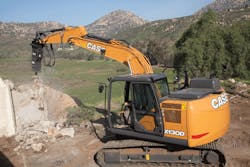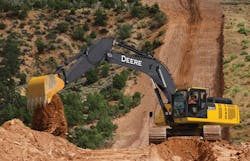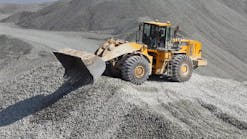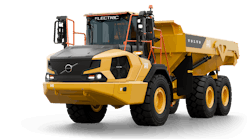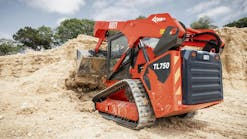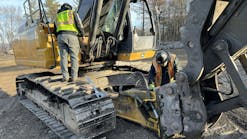“Managers can keep operating costs down by making good use of telematics,” says Sung Sook Kim, product manager, mid-sized excavators, Volvo CE. “We often hear that telematics programs overwhelm them with data and don’t provide actionable insights, which is why we developed ActiveCare Direct.”
The ActiveCare Direct model uses the company’s telematics to cull and simplify data, and then alerts managers when immediate attention is needed, providing the probable cause, a recommended solution, and the potential consequences of not acting. There is also a mechanism to provide monthly reports that managers can use to optimize utilization, improve uptime, and reduce operating costs. Volvo’s dealers are the linchpin.
“Another tip is not to operate too fast,” Kim says. “Quick starts and stops, fast turns, and rapidly slewing buckets mean material is likely falling out of the bucket and has to be cleaned up. That is wasted time and fuel.
“Misusing attachments is another unsafe and inefficient practice that happens sometimes,” Kim says. “A common example is using a hydraulic hammer as a pry bar. The hammer is designed to be used straight down or at a certain angle. But if it’s also used to dig around or pick up and turn large chunks of concrete or rock, it puts excessive side load on the tool. That causes excessive wear on the bushing and fractures in the tool, leading to seal issues and leaks. If a hammer has to be rebuilt, it’s very expensive.”
Kim says it is also important to right-size your excavator to the job. “You don’t always need the biggest one you can get,” he says. “In fact, that may require more transport hassle, rework, and fuel.”
How training saves excavator costs
Keith Kramlich, national product and training manager for Takeuchi, stresses operator training as a potential money saver. “Features aside, a good operator is a productive operator, and productivity leads to efficiency,” Kramlich says. “For example, a good operator knows exactly how much material the machine can handle and will take smooth, precise cuts, allowing the machine to work at its max potential without stalling out or pushing the hydraulics over relief. Every time the bucket stops in the dirt/material instead of moving continuously, operators waste time, fuel, and money.”
Aaron Kleingartner, product and dealer marketing manager for Doosan, agrees, and ties in the importance of managing idle time.
“Fleet managers should train excavator operators, especially if they’re new, about how to properly use the machine,” he says. “One of the most important aspects of training is teaching the excavator operators about the importance of turning off the excavator when it’s not working. Excessive excavator idling wastes fuel and is not ideal for the Tier-4-compliant diesel engine and the aftertreatment systems installed in the machine to meet Tier 4-emission requirements.”
Justin Steger, solutions marketing manager, site development & underground for John Deere, specifically points to regeneration in Tier 4 excavator engines.
“Training operators to utilize the standard features in the machine such as auto-idle and auto-shutdown will help save on unnecessary fuel burn, as well as preserve lease, rental, or warranty hours where applicable,” Steger says.
“Optimizing fuel burn to when the machine is productively working will also help reduce the amount of regeneration needed to burn off excess particulate in the engine emission system,” Steger says. “Taking advantage of passive regenerations that occur while the machine is working takes training and familiarization so that operators understand the machine is regenerating while they work with minimal interruption, rather than getting to the point of needing a parked regeneration.”
Just as fleet managers can partner with manufacturers and dealers on training, they can also utilize the contacts to buy and/or negotiate maintenance plans to possibly cut costs further, particularly if they buy in volume.
“Many new equipment purchases come with planned maintenance contracts, which can take some of the burden of equipment maintenance scheduling off of the shoulders of the equipment owner,” says Nathaniel Waldschmidt, product manager, excavators, Case Construction Equipment. “As an example, all of Case’s D Series excavators come standard with Case ProCare, which includes a three-year, 3,000-hour full-machine factory warranty; three-year, 2,000-hour planned maintenance contract; and a three-year Advanced Case SiteWatch telematics subscription.”
Jason Boerger, marketing manager—excavators, for Bobcat, concurs. “A PM contract keeps the excavator operating on the job site by ensuring service is performed on schedule and at a convenient time,” he says. “A PM contract with a planned maintenance schedule can extend the life of the equipment, minimize downtime, and save money over time.”
In addition to telematics and service offerings, OEMs have continued to add other technology to the size class, including machine control and safety features.
Waldschmidt points out that Case recently announced the availability of the iCON iXE3 Semi-Automatic Excavator solution through its dealers.
“Available for both 2D and 3D applications, this new semi-automatic excavator solution allows the operator to automate the boom, bucket, tilt bucket, or tilt rotator bucket independently or in combination,” Waldschmidt says.
“The semi-automatic functionality has built-in undercut protection, eliminating over-digging into undisturbed soil,” Waldschmidt says. “By automatically controlling the functionality of the excavator system, the solution allows the operator to execute complex tasks while increasing productivity through the speed and accuracy of the work, even for less experienced operators.”
Excavator safety advances
Komatsu product manager Andrew Earing tells Construction Equipment about new safety technology coming to his models in the size class.
“Coming soon to the PC130-11, PC138USLC-11, and PC170LC-11 is the optional Komvision camera system,” Earing says. “This system utilizes the rearview camera with two or three additional cameras to provide a bird’s-eye view of the area around the machine for improved operator awareness. This feature is important because it improves situational awareness and also provides a reference line for the counterweight swing radius to aid with machine operation.”
Hyundai has also added a safety feature. “All A Series models have an all-new Auto Safety Lock function,” says Mike Fuller, Hyundai senior product manager.
“First of all, the engine will not start if the pilot system is engaged,” Fuller says. “Then after starting engine, if in the event any controls are being pressed/moved when the safety lever is engaged, or pilot is engaged, the machine will not function at all. The operator has to make sure he or she is not touching any of the controls, lock out the pilot, and re-engage the system in order to operate the machine.”
Caterpillar released several new “Next Gen” machines in the size class as this article was being compiled in December, with some notable tech included. The Cat 335 is a 36,200-pound example.
Factory-integrated Cat technologies on the 335 are designed to assist operator performance, no matter the experience level, Cat says, to increase machine efficiency by up to 45 percent compared to manual operation.
Cat Payload technology offers on-the-go weighing of material to help prevent overloading or underloading to maximize efficiency. By calculating the load being lifted and comparing it to the rated load for the excavator, Lift Assist lets operators know when the machine is within a safe working range or action is necessary to avoid tipping.
Operators can cut and fill to exact specifications without overcutting when using the standard Cat Grade with 2D. The system stores up to four of the most-used target depth and slope offsets to save time. Upgrades to Cat Grade with Advanced 2D or Cat Grade with 3D are available.
On the maintenance side, the use of Cat Remote Services allows companies to troubleshoot and update machine software. Remote Troubleshoot allows Cat dealers to perform diagnostic testing remotely and pinpoint potential issues. Remote Flash allows for on-board software to be updated at a time when it is convenient to the work schedule and without a technician being present.
